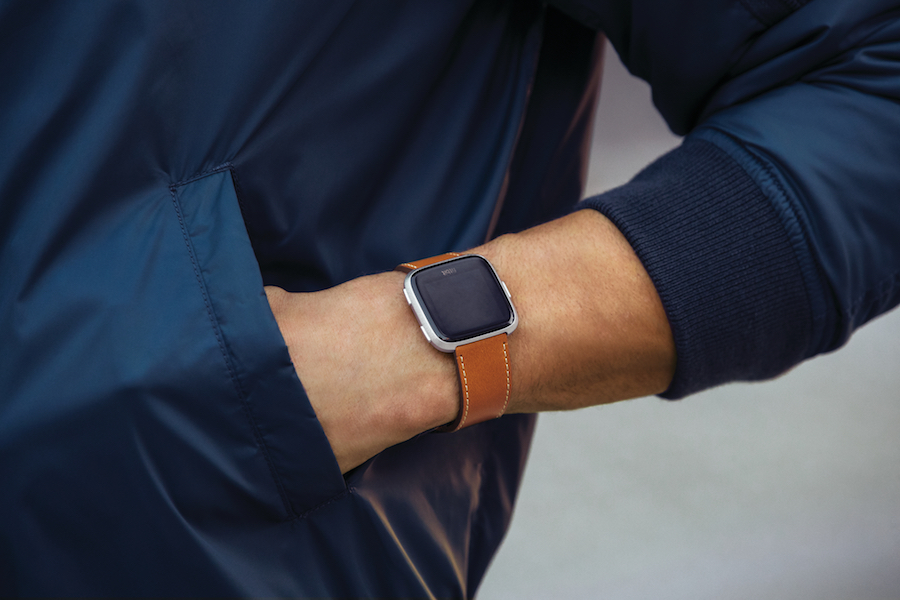By Eric Smith
For the second consecutive quarter, Fitbit Inc.’s Versa delivered a significant revenue boost for the wearables company. The Versa, which sold out in the quarter ended June 30, helped Fitbit lift smartwatch sales to 55 percent of the company’s 2.7 million total of devices sold in Q2, up from 30 percent in Q1.
That contributed plenty to Fitbit’s $299 million in revenue, which beat consensus Wall Street estimates by $13.9 million. And though Fitbit reported a net loss of $54 million, or (22) cents per share, that beat analysts’ expectations by 2 cents.
The story of the quarter was clearly the Versa, which “strengthened our brand relevancy and highlights the opportunity to regain market share as we progress in the smartwatch category and continue to deliver both hardware and software offerings that consumer finds compelling,” CEO James Park said on Wednesday afternoon’s conference call with analysts.
“The success of Versa has improved the company’s positioning with retailers, solidified shelf space for the Fitbit brand and has provided a halo effect to our other product offerings. Retailers have been looking for a counterbalance to Apple, and Versa has delivered it.”
Fitbit said the company sold 2.7 million devices in Q2, which was up sequentially while the year-over-year rate of decline in devices sold dropped to 20 percent in the second quarter versus 27 percent in the first quarter.
“In the second quarter, Fitbit Versa outsold all Samsung, Garmin and Fossil smartwatches in North America combined,” Park said. “With the strong consumer receptivity for Versa, demand has outpaced supply, and we have chosen to add an additional production line. Since launch we have also seen a significant uplift in North America POS trend.”
Fitbit doubled down on the Versa last quarter, and it paid off. The company pulled forward cost and increase media and advertising spend to support the launch of Versa, Park said.
“Versa success strengthens channel partner relationships, and we believe provides momentum into the back half of the year,” Park said. “Also, we continue to make progress transitioning our data infrastructure to Google’s cloud where we expect cost savings to begin in 2019.”
That success caught the eye of analysts like Jim Duffy of Stifel, who wrote in a note to investors: “Consumer reception to Versa is an improvement from the Ionic launch for Holiday 2017, and FY18 targets appear more achievable than we thought three months ago.”
Here is a Recap of Fitbit’s Q2 2018 Financial Highlights:
- Sold 2.7 million wearable devices. Average selling price increased 6 percent year-over-year to $106 per device driven by the growing mix of smartwatches.
- U.S. revenue represented 61 percent of revenue or $182 million, down 8 percent year-over-year.
- International revenue represented 39 percent and declined 24 percent year-over-year to $117 million: EMEA revenue declined 39 percent to $66 million; Americas, excluding U.S., revenue declined 35 percent to $16 million and APAC revenue grew 66 percent to $35 million, all year-over-year, respectively.
- New devices introduced in the past year, Fitbit Ionic , Fitbit Versa , Fitbit Ace and Fitbit Aria 2 and accessory Fitbit Flyer, represented 59 percent of revenue.
- GAAP gross margin was 39.8 percent, and non-GAAP gross margin was 40.9 percent. Both GAAP and non-GAAP gross margins were negatively impacted by the change in mix towards smartwatches, partially offset by improved warranty costs.
- GAAP operating expenses represented 73 percent of revenue, and non-GAAP operating expenses represented 65 percent of revenue.
Q2 2018 Operational Highlights
- Smartwatch revenue grew to 55 percent of revenue, up from 30 percent on a sequential basis.
- Versa outsold Samsung, Garmin and Fossil smartwatches combined in North America.
- The retail channel reduced tracker inventory, depressing reorder rates and tracker sales. EMEA was disproportionately exposed as tracker revenue was a larger percentage of revenue in the region as compared to the U.S. in prior quarters. The company expects Q2 to be the trough in the year-over-year decline in tracker sales.
- Active community of users: 56 percent of active users viewed Fitbit Feed in the quarter, and our female health tracking feature has experienced more than 2.9 million total signups.
- 60 percent of activations came from new users, while 40 percent came from repeat buyers. Of the repeat buyers, 51 percent were previously inactive for 90 days or greater, up from 39 percent in Q2 2017, driven by smartwatches.
Fitbit expects Q3 revenue to decline 3 percent year-over-year to a range of $370 million to $390 million, and the EMEA region to return back to growth. Fitbit reiterated the company’s full-year 2018 revenue guidance of approximately $1.5 billion.
Photo courtesy Fitbit
[author] [author_image timthumb=’on’]https://s.gravatar.com/avatar/dec6c8d990a5a173d9ae43e334e44145?s=80[/author_image] [author_info]Eric Smith is Senior Business Editor at SGB Media. Reach him at eric@sgbonline.com or 303-578-7008. Follow on Twitter or connect on LinkedIn.[/author_info] [/author]
















